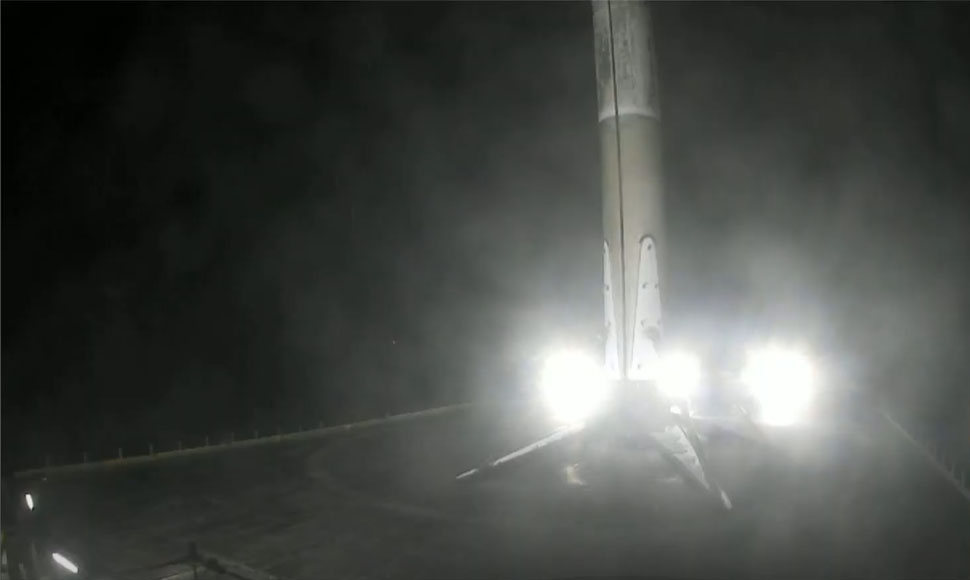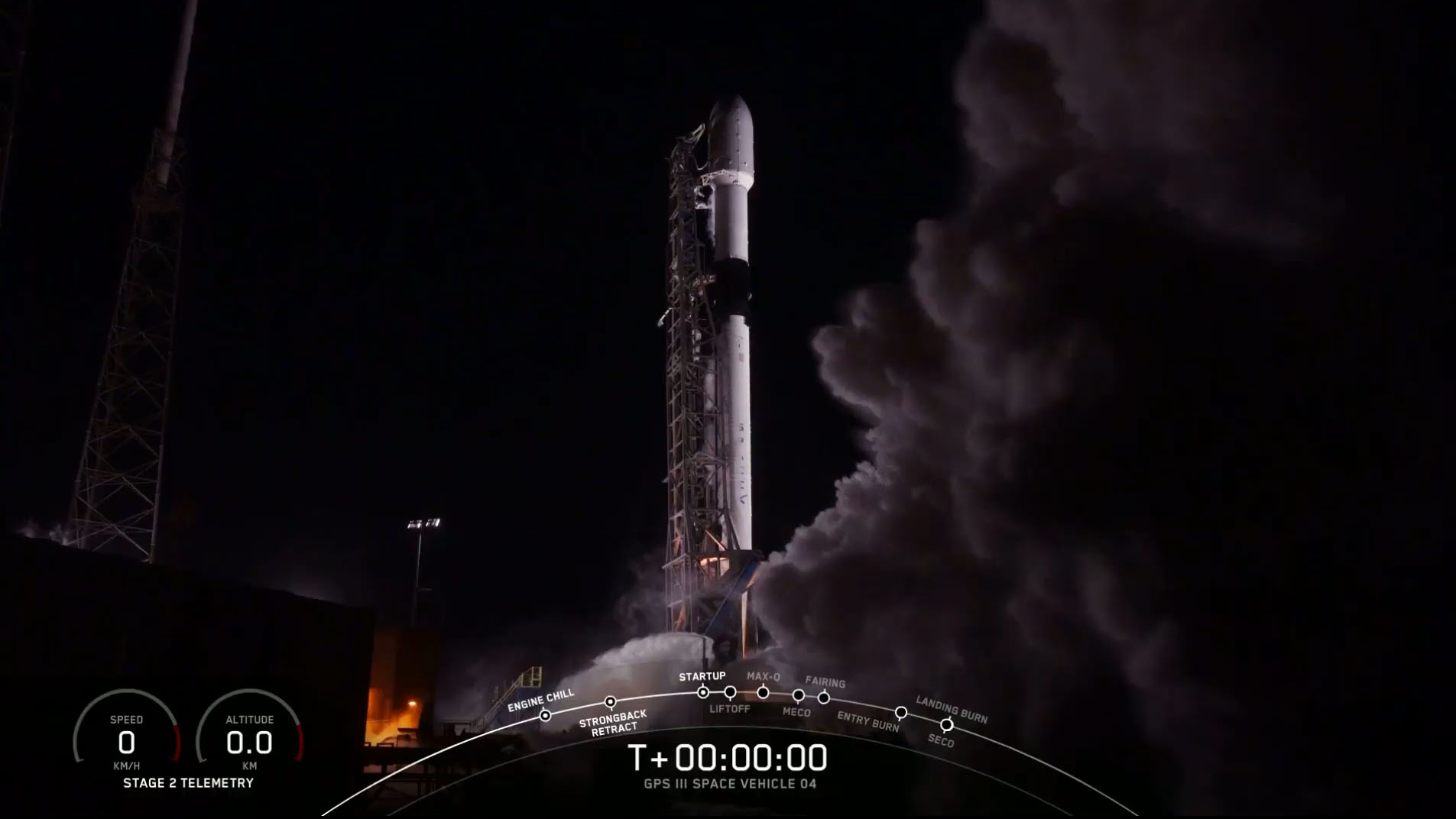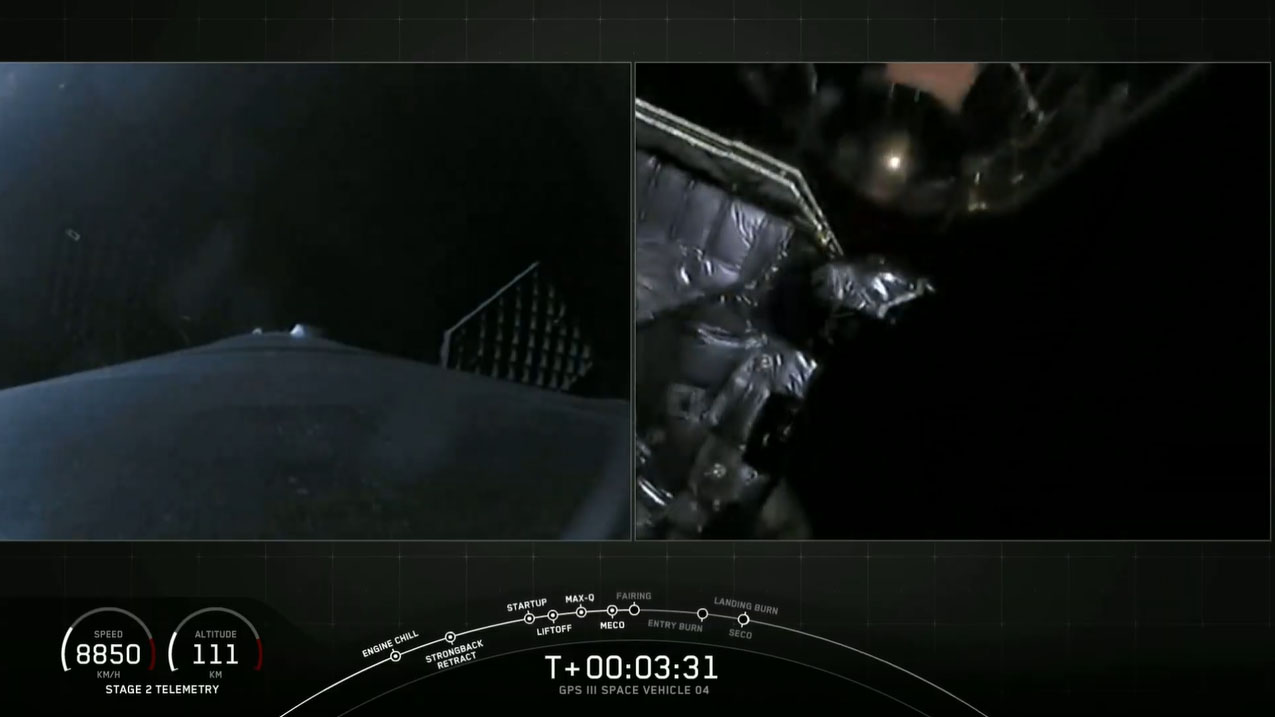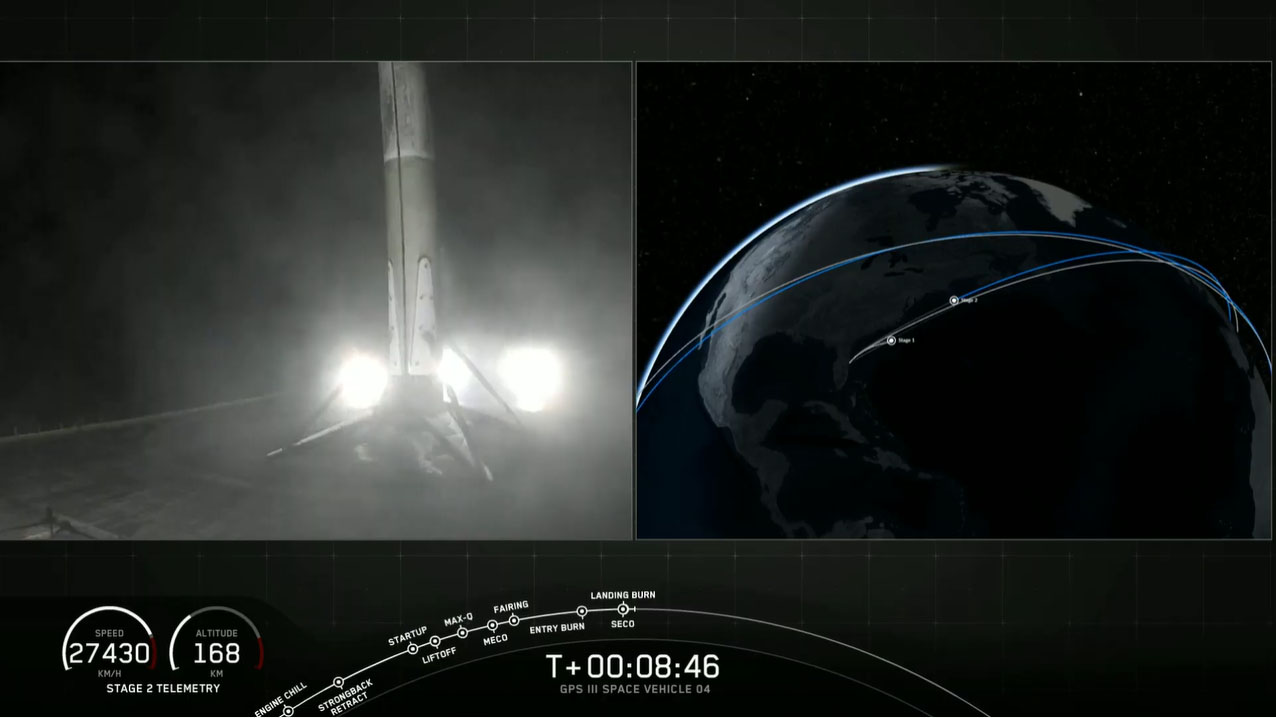SpaceX launches next-gen GPS satellite for US Space Force, lands rocket
CAPE CANAVERAL, Fla. — SpaceX successfully launched an advanced GPS satellite for the U.S. Space Force on Thursday (Nov. 5), marking the first launch in nearly two weeks here on the Space Coast.
One of the company's two-stage Falcon 9 rockets blasted off from Space Launch Complex 40 at Cape Canaveral Air Force Station here at 6:24 p.m. EST (2324 GMT), carrying the GPS III-SV04 satellite to orbit. Nine minutes later, the rocket's first stage touched down on the deck of "Of Course I Still Love You," one of SpaceX's two drone ships.
The GPS III-SV04 mission had been set to follow on the heels of a United Launch Alliance (ULA) Atlas V rocket, which was scheduled to loft a U.S. spy satellite from Cape Canaveral on Tuesday (Nov. 3). However, the Atlas V launch was delayed twice due to issues with ground systems equipment. ULA is now targeting Friday (Nov. 6) for that liftoff.
Related: The U.S. GPS satellite network explained

It was a crystal clear night here on the Space Coast, and onlookers were able to follow the rocket through the different phases of launch. A nebula-like cloud, typically visible on clear nights, formed around the rocket as the first and second stages separated. The booster's reentry burn was also visible from a press viewing area.
Tonight's GPS mission had been waiting to get off the ground since SpaceX was forced to call an abort on Oct. 2. In the final seconds of the countdown that day, the Falcon 9's computer detected an engine anomaly, and the rocket’s onboard flight termination system shut the engines down. Crews were able to safe the vehicle and, after a thorough investigation, pinpoint the issue.
SpaceX determined that residue from a "masking lacquer," which is designed to protect sensitive engine parts during anti-corrosion anodizing treatment, was left behind post-treatment. The lacquer ended up blocking 0.06-inch-wide (1.6 millimeters) vent holes for valves in two of the nine Merlin engines on the Falcon 9's first stage, SpaceX representatives said in a news briefing on Oct. 28.
Get the Space.com Newsletter
Breaking space news, the latest updates on rocket launches, skywatching events and more!
The same traces of lacquer were detected in engines on two other Falcon 9 first stages — one on the rocket that will launch the Sentinel-6 Earth-observation satellite and one on the booster that will launch Crew-1, SpaceX's next astronaut mission. SpaceX has swapped out the affected engines. The Crew-1 launch date, scheduled for Nov. 14, was not affected by this swap. However, SpaceX and NASA are postponing the Sentinel-6 mission until after Crew-1, setting a new target date of Nov. 21.
Today’s flight marks the third GPS delivery for SpaceX. Two previous advanced GPS III missions also launched on Falcon 9 rockets, including one this past June. Another of the satellites launched on the final flight of ULA's Delta IV Medium in August 2019.
The U.S. military plans to launch a total of 10 upgraded GPS satellites, which will replace aging members of its current constellation. SpaceX has secured additional contracts to launch the next two GPS III missions, which are expected to lift off sometime next year.
Built by Lockheed Martin in Colorado, the GPS III-SV04 satellite launched today is the fourth member of an upgraded generation of GPS navigation spacecraft that beam down higher-power signals that are more resilient to jamming and boast additional broadcast frequencies to make the GPS network more compatible with other similar constellations, Lockheed representatives have said.
Related: See the evolution of SpaceX's rockets in pictures
Falcon's fury

The 227-foot-tall (70 meters) Falcon 9 is SpaceX's workhorse, and the rocket boasts more than 1.5 million pounds of thrust at liftoff. Today's mission featured a fresh-off-the-factory-floor Falcon, its exterior stark white for its first trip to space.
SpaceX has been relying heavily on its fleet of veteran rockets, with many Falcon 9 first stages having racked up five or more flights each. The booster that launched today, known by the SpaceX designation B1062, could be the last brand-new one we see launch a GPS satellite, as the U.S. government has given SpaceX the green light to launch future military missions on flight-proven boosters.
That decision followed on the heels of another recent announcement to allow SpaceX to recover the rocket's first stage during national security missions — something that was previously not allowed. The next two GPS missions, which are already scheduled to fly on SpaceX rockets sometime next year, will now launch atop refurbished rockets.
That announcement is a first for national-security payloads and could result in savings of nearly $53 million for American taxpayers across the two flights, Space Force officials said.
What's in a name?
The military has given nicknames to each of the upgraded GPS satellites, naming them after famous explorers. The satellite that launched tonight was given the moniker "Sacagawea" after the Shoshone guide who helped Lewis and Clark on their expedition through the American West in the early 1800s.
Previous satellites have been named "Vespucci" and "Magellan" in honor of explorers Amerigo Vespucci and Ferdinand Magellan. The satellite that launched in June was originally dubbed Columbus, but it recently received a new nickname: "Henson," in honor of black explorer Matthew Henson, who was part of the first expedition to the North Pole more than a century ago.
All of the monikers are unofficial nicknames given to the satellites prior to launch as a way of honoring explorers of the past and continuing a spaceflight tradition of naming spacecraft.
The next few missions already have names selected for the respective satellites. The fifth satellite, GPS III-SV05, will be called Neil Armstrong. Space Force officials say other satellites to come will be named after Amelia Earhart, Sally Ride and Katherine Johnson.
Flight milestones
Today's mission marks the 97th Falcon 9 rocket to fly and the 20th mission of 2020 for SpaceX. It also marks the 64th successful booster recovery. SpaceX's drone ship, "Of Course I Still Love You," was positioned out in the Atlantic Ocean, awaiting its recovery attempt.
The company's other drone ship, "Just Read the Instructions," is hanging out in Port Canaveral for now, awaiting its next mission. The massive ship, which now has 11 rocket catches under its belt, transferred to the East Coast earlier this year, after receiving some sweet upgrades.
Today's launch also was the first since August to feature a brand new SpaceX booster. The engine issue temporarily grounded SpaceX’s new boosters, allowing the company to focus on veteran rockets and its own Starlink internet constellation. In the month of October, SpaceX launched a record 180 Starlink satellites, bringing the total number launched to nearly 900.
B1062 was the star of the show today, and it will also likely be the first Falcon 9 booster to carry two different GPS satellites to orbit; it's scheduled to launch the next one, sometime next year. This will mark the first time that a previously flown Falcon 9 will hoist one of these advanced global positioning satellites.
With the last Starlink mission, which launched on Oct. 24, SpaceX hit a major milestone: 100 successful Falcon launches. This total encompasses the entire Falcon family, including the pioneering (and long discontinued) Falcon 1 and the currently operational Falcon Heavy. SpaceX tweeted out a video recently to commemorate the milestone.
Fairing recovery
One of SpaceX's two fairing catchers, GO Ms. Chief, is waiting in the recovery zone this evening. The two boats are outfitted with massive nets to catch the falling pieces of the rocket’s payload fairing, or nose cone, after they are deployed during flight. (SpaceX fairings come back to Earth in two halves.)
GO Ms. Chief departed Port Canaveral on Wednesday (Nov. 4) ahead of today’s launch. The vessel traveled solo this time as its counterpart, GO Ms. Tree, remained in Port in Florida. (The boat was damaged on a previous mission and could presumably still be undergoing repairs.)
During a prelaunch broadcast, SpaceX engineer Jessica Anderson announced that the company would not be attempting a catch, but instead would scoop up the fairing pieces after they land in the ocean. The boats have the capability of catching falling fairings in their nets, or scooping them out of the water after they splash down. Those efforts should occur approximately 45 minutes after liftoff.
With the help of Ms. Tree and Ms. Chief, SpaceX has been successful in its attempts to reuse more of the rocket, even reusing several fairings on multiple missions.
Up next for SpaceX is Crew-1, its first contracted crewed mission to the International Space Station for NASA. A different Falcon 9 rocket will ferry four astronauts to the station for a six-month stay. That flight is set to blast off from Pad 39A at NASA’s Kennedy Space Center in Florida on Nov. 14 at 7:29 p.m. EST (0029 GMT on Nov. 15).
Follow Amy Thompson on Twitter @astrogingersnap. Follow us on Twitter @Spacedotcom or Facebook.
Join our Space Forums to keep talking space on the latest missions, night sky and more! And if you have a news tip, correction or comment, let us know at: community@space.com.

Amy Thompson is a Florida-based space and science journalist, who joined Space.com as a contributing writer in 2015. She's passionate about all things space and is a huge science and science-fiction geek. Star Wars is her favorite fandom, with that sassy little droid, R2D2 being her favorite. She studied science at the University of Florida, earning a degree in microbiology. Her work has also been published in Newsweek, VICE, Smithsonian, and many more. Now she chases rockets, writing about launches, commercial space, space station science, and everything in between.












